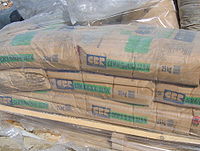
Photo from wikipedia
This study explored the possibility of using reverse osmosis (RO) reject water as a mixing water for producing cementitious bricks using calcium sulfoaluminate (CSA) cement along with gypsum, and it… Click to show full abstract
This study explored the possibility of using reverse osmosis (RO) reject water as a mixing water for producing cementitious bricks using calcium sulfoaluminate (CSA) cement along with gypsum, and it investigated the changes in the properties of CSA cement pastes when RO reject water was used. The results were compared with those obtained using purified water and seawater. Overall, the use of RO reject water improved the cement paste’s strength. Given that the use of RO reject water very slightly affected ettringite formation but more significantly influenced the Al2O3-Fe2O3-mono (AFm) phases (i.e., monosulfate, kuzelite, and Friedel’s salt) and amorphous aluminum hydroxide (AH3), the strength improvement was likely mainly due to the formation of Friedel’s salt rather than ettringite formation. This study also demonstrated that the use of RO reject water for brick production satisfied the Korean Standards (KS) F 4004 and toxicity characteristic leaching procedure (TCLP); thus, it is recommended to use RO reject water as a mixing water to produce CSA cement bricks for use in construction.
Journal Title: Applied Sciences
Year Published: 2019
Link to full text (if available)
Share on Social Media: Sign Up to like & get
recommendations!